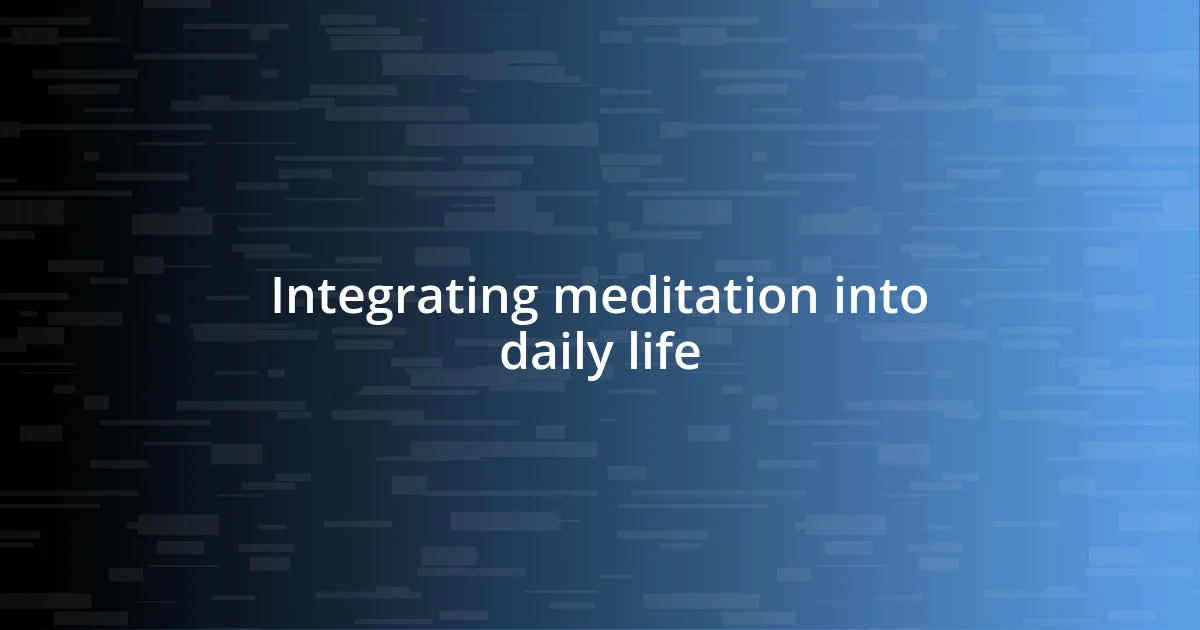Key takeaways:
- Meditation offers numerous benefits, including improved emotional resilience and self-awareness, helping to navigate life’s challenges with greater calm.
- Creating a dedicated meditation space and establishing a consistent routine enhances the overall practice, making it feel more intentional and effective.
- Integrating mindfulness into daily activities and tracking progress through journaling can significantly enrich the meditation experience and deepen self-discovery.

Understanding meditation benefits
Meditation offers a treasure trove of benefits, from reducing stress to enhancing focus. I remember the first time I sat in silence, my thoughts racing and my body tense. But within moments, I felt the heaviness lift; it was as if a fog was clearing, revealing a landscape of calmness and clarity. Have you ever noticed how a few deep breaths can shift your entire mood?
One of the key benefits I’ve experienced is improved emotional resilience. In challenging moments, I find solace in the stillness I cultivated through meditation. It’s empowering to know that I have a tool that allows me to navigate life’s ups and downs with more grace. Can you think of a time when a little inner peace could have changed your reaction to a stressful situation?
Another profound aspect of meditation is the way it fosters self-awareness. I used to rush through my day on autopilot, rarely pausing to check in with myself. Now, I periodically take moments to reflect, which helps me understand my feelings and choices more deeply. Have you ever considered how slowing down can enhance your understanding of yourself? It’s a game-changer!

Choosing the right meditation style
Choosing the right meditation style can feel overwhelming, especially with the variety of options available. For me, it was essential to explore different techniques before settling on a method that resonated with my needs. I remember trying guided meditations that helped calm my thoughts initially, but eventually found solace in mindful breathing, which enabled me to connect with my breath more intimately.
Sometimes, I find myself reflecting on the importance of the meditation environment. When I first started, my surroundings were often noisy and chaotic, making it difficult to concentrate. Once I made an effort to create a peaceful space at home, I noticed a significant shift in my practice. Can you think of a space that makes you feel at ease? Finding a quiet corner can truly elevate your meditation experience.
Many people gravitate toward meditation styles like Zen, Transcendental, or loving-kindness. Each has its unique flavors, tailored to different preferences. Personally, I’ve learned that what works for one person may not work for another, and that’s perfectly okay. I’ve dabbled in various styles, but it was the simple act of loving-kindness that touched my heart and encouraged me to cultivate compassion. It’s about finding what speaks to you.
| Meditation Style | Description |
|---|---|
| Mindfulness | Focus on the present moment, observing thoughts and feelings without judgment. |
| Transcendental | Involves repeating a mantra to settle the mind and achieve a deeper state of relaxation. |
| Zen | Emphasizes seated meditation (Zazen) and focusing on the breath, often with a structured environment. |
| Loving-Kindness | Focuses on developing an attitude of love and kindness towards oneself and others. |

Creating your meditation space
Creating a meditation space is one of the most rewarding steps in my meditation journey. When I first set out to establish mine, I envisioned a serene oasis amidst the chaos of everyday life. It wasn’t just about finding a quiet corner; it was about infusing that space with intention. I remember selecting calming colors, soft lighting, and even a few plants. These elements worked together to transform a mundane room into a personal sanctuary that invites stillness and reflection.
To guide you in creating your own meditation space, consider these key elements:
- Choose a Quiet Location: Find a spot in your home where you can minimize distractions.
- Incorporate Natural Elements: Adding plants or natural materials can enhance the sense of tranquility.
- Use Comfortable Seating: A cushion or chair that supports your posture can make a significant difference.
- Personal Touches: Include items that evoke peace, like candles, crystals, or a favorite blanket.
- Control the Lighting: Soft, warm lighting can create a soothing atmosphere, perfect for meditation.
Each of these aspects contributes to a feeling of peace, making it easier to settle into your practice. I still remember how the aroma of calming essential oils filled the air during my first few sessions and how that simple addition invited a deeper sense of calmness. Have you thought about how each little detail can create a welcoming embrace for your mind and body?

Establishing a consistent routine
Establishing a consistent meditation routine was a game-changer for me. I started by committing to just five minutes every morning, which seemed manageable. Over time, those few minutes turned into a sacred ritual that anchored my day. Isn’t it incredible how starting small can lead to profound changes?
I still vividly recall the days when I would skip my practice, thinking I didn’t have the time. Those moments taught me that even a short session is better than none. It’s about honoring your commitment to yourself, no matter how fleeting the time may feel. Have you noticed what happens when you prioritize your well-being, even for a few minutes?
As my routine solidified, I also found that setting a specific time helped me stay accountable. I once experimented with various times of the day, but I discovered mornings worked best. It felt refreshing to begin each day with intention, almost like a gentle push into mindfulness. How do you think a consistent schedule could impact your own meditation practice?

Overcoming common meditation challenges
Meditation often comes with its own set of challenges, and I can relate to the frustration of a wandering mind. In the beginning, I would sit down, ready to find my center, only to be bombarded with thoughts about my to-do list or that conversation I had earlier. I found that simply acknowledging these thoughts without judgment was a game changer. Instead of fighting them, I learned to gently guide my focus back, like a friendly reminder to my own restless mind, and it made all the difference.
Another challenge I faced was discomfort during longer sessions. I vividly remember a few instances where my legs would cramp, or I’d feel that nagging stiffness in my back. I quickly realized that comfort is key! Experimenting with different postures transformed my experience; sitting on a cushion versus a chair, or even changing my position now and then, allowed me to maintain my focus without physical distractions. Have you taken the time to explore what makes you feel comfortable during meditation?
Distractions have been a constant companion through my meditation journey. I used to let even the slightest noise derail my focus, which led to frustration. But then I had a lightbulb moment: what if I embraced the sounds instead? I began noticing how background noise, like birds chirping or the wind rustling leaves, could enhance my awareness and connect me deeper to the present moment. Have you ever considered how surrendering to your surroundings might bring you peace rather than disturbance?

Tracking progress and reflections
Tracking progress in my meditation practice has become invaluable. I started a simple journal to note my experiences right after each session. Reflecting on how I felt—whether calm, restless, or somewhere in between—helped me recognize patterns over time. Have you ever noticed how writing about your feelings can lead to deeper self-discovery?
I found that comparing notes from one week to the next illuminated subtle shifts in my mindset. For instance, after a particularly stressful week, I could see how meditation helped me regain my balance. Seeing these changes on paper felt like a personal victory. Isn’t it fascinating to witness tangible evidence of growth?
What surprised me most was the connection between my reflections and my daily mood. On days when I took the time to write about my meditation experience, I felt more grounded and engaged. It highlighted the importance of not just the practice itself but also the act of pausing to process it. How do you celebrate your own progress and insights during your meditation journey?

Integrating meditation into daily life
Integrating meditation into daily life can feel like a daunting task, but I’ve discovered that even small adjustments can make a significant impact. For instance, I started setting aside just five minutes each morning to meditate before diving into my day. This tiny habit created a ripple effect, allowing me to respond to stress more calmly and intentionally. Have you tried carving out those few moments for yourself?
I also found that blending mindfulness with routine activities transformed my daily experiences. Taking a mindful walk, where I pay attention to each step and the sensations of the air, allowed me to practice meditation without the need for a formal setup. This integration has helped me appreciate the present more, almost like refreshing my perspective with every breath. Have you ever considered how simple activities can be a form of meditation in disguise?
Moreover, I began to use reminders to anchor my practice throughout the day. For example, I’d set an alarm on my phone, prompting me to take a moment to breathe deeply when life became hectic. Initially, it felt a bit awkward, but soon those reminders became a lifeline, guiding me back to a state of balance. What small cues can you introduce into your day to help you reconnect with mindfulness?














